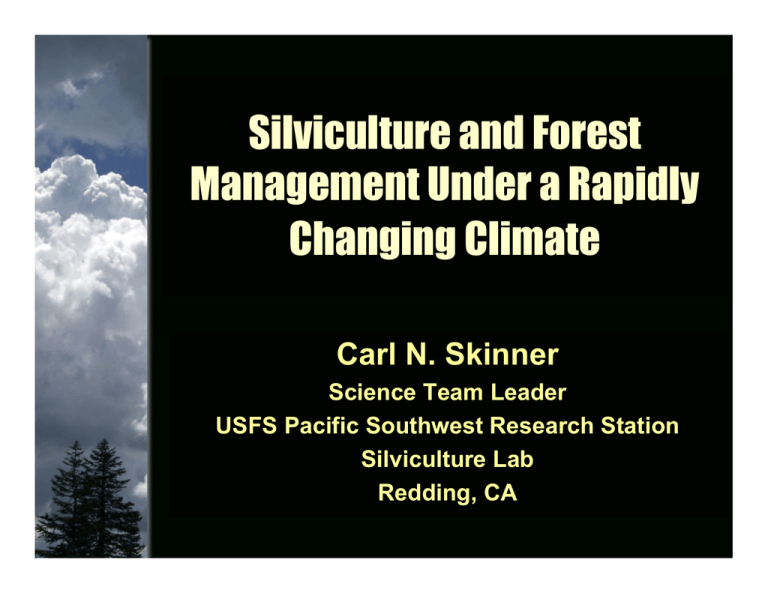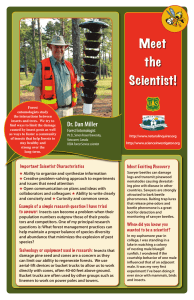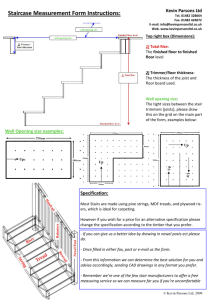Silviculture and Forest Management Under a Rapidly Changing Climate Carl N. Skinner
advertisement

Silviculture and Forest Management Under a Rapidly Changing Climate Carl N. Skinner Science Team Leader USFS Pacific Southwest Research Station Silviculture Lab Redding, CA Climate: Patterns of Life on Earth Source: http://www.geog.ubc.ca/~daniels/biomes/explore Warming Climate Climate & Silviculture • Forest Life Cycles Decades – Centuries – Millennia • Forest Management Years – Decades Stable climate? • Strategies for Adaptation to an Ever Changing Climate Awareness – Potential for Changes Global Change? Control .5 x CO2 2 x CO2 4 x CO2 Study the Past – Monitor the Present Model the Future Piecing Together a Picture of Climate History • Ice Cores Gas, Isotopes, Dust • Sediment Cores Pollen, Charcoal, Fossils • Pack-rat Middens • Tree-rings Ring width, Ring density, Isotopes, Fire scars • Instrumental Record Climate is always changing. Just sometimes faster than at other times. 20th Century Climate • Unusually favorable for growing trees • Climate Fluctuations Have Been Generally Less Extreme Than in the Past Dry/Wet – Cool/Warm • Should Expect More Extremes in Future History Modeling Glaciation > 14,000 ybp Early Holocene Subalpine Shrubs – Woodland ~ 13,000 ybp Subalpine Woodland Early Holocene W. White Pine – Jeffery Pine 13,100 – 11,100 ybp Montane Shrubs Early Holocene Mt-mahogany – Juniper Jeffrey Pine – Oregon White Oak 10,000 – 7,400 ybp Oregon White Oak – Juniper Jeffrey Pine – Grasses 10,000 – 7,400 ybp Mt-mahogany – Juniper – White fir Jeffrey Pine – Oregon White Oak – California Black Oak 7,400 – 4,450 ybp Jeffrey Pine – W. White Pine – True Fir –Whitebark Pine 4,450 – 2,150 ybp High True Fir Pollen 2,150 – 1,000 ybp Jeffrey Pine – Incense Cedar – True Fir W. White Pine 1,000 ybp - present Briles, Whitlock, Bartlein 2005 Climate Change • Temperatures • Water • Disturbance • Vegetation – Habitat Climate Change Temperatures •• Warming Warming •• Night Night vs. vs. Day Day •• Winter Winter vs. vs. Summer Summer •• Latitude Latitude –– Poles Poles vs. vs. Equator Equator Global Temperature Trends Black = Instrumental Record 1861-1990 Others = Reconstructed from tree rings From: Jones et al. 2001 Science 292: 662-667 Projected Global Temperature Changes For 2020-2030 compared to 1990-2000. Projections show greatest change on land and high latitudes. Climate Variation ~ Warm/Average/ Cool Temperature Mean Mean 1600-1980 1600-1980 From N. Hem. Temp. Grid Briffa et al. 2002 Cool / Average / Warm Climate Change •• Temperatures Temperatures • Water Storms – energy Extremes Reorganization •• Disturbance Disturbance •• Habitat Habitat Water • Snow melt Earlier / more rapid • Stream flow Dominated more by rain rather than snow More rapid rain related peaks Less summer flows Climate Variation ~ Dry/Average/ Wet PDSI Mean Mean 1650-1990 1650-1990 100 yr Windows From PDSI Grid of Cook et al. 2004 Dry / Average / Wet Cool / Average / Warm Ocean/Atmosphere Interactions • Warming Atmosphere Can hold more moisture Increased energy – stronger storms • Warming Oceans Evaporate greater quantities of water Alter current locations and strength Sierra San Pedro Martir Standardized Index Values Baja California, Mexico 4 3 2 1 0 -1 -2 -3 -4 1700 1725 1750 RING WIDTH PDO+NINO3 1775 1800 1825 1850 1875 1900 1925 1950 1975 2000 Climate Change • Disturbance Drought Insects Fire Drought Extreme Extreme droughts droughts may may reset reset ecosystems ecosystems across across broad broad regions regions and and open open niches niches for for regeneration regeneration or or new new invasions. invasions. deMenocal 2001 San Bernardino Mts Sierra San Pedro Martir Baja California, Mexico Mt. Hemlock 20th Century Droughts Western Juniper Hayes Range, NV Climate Change • Disturbance Drought Drought Insects Fire Fire Climate Change Insects • Physiology Temperature • Phenology Periods of Activity Timing of Activity – Hosts • Distribution 3.6O F of Temp Rise = 370 mi / 1,100 ft Lodgepole Jack Pine Mt. Pine Beetle Climate Change & Mt. Pine Beetle Jack Pine Lodgepole E. White Pine Mt. Pine Beetle From: J.A. Logan & J.A. Powell In press Loblolly Pine Climate Change • Disturbance Drought Drought Insects Insects Fire Annual Area Burned 11 Western States Millions of Hectares 2.5 2.0 1.5 1.0 0.5 0.0 1915 1925 1935 1945 1955 1965 1975 1985 1995 From: From: Arno Arno & & Allison-Bunnell Allison-Bunnell 2002 2002 33 Fire Scars Fire Suppression Effect Changing Changing stand stand conditions conditions over over 20 20thth Century Century Climate Variation & Fire? • Temperature – Fire Frequency • Moisture Fire Extent Latitudinal Gradient PDO + ENSO - Fire Response Eastside Cascades, WA – (Hessl et al. 2004) PDO+, El Nino Eastside Cascades, CA - (Norman & Taylor 2003) PDO +/-, El Nino Sierra Nevada, NV - (Taylor & Beaty 2005) PDO +/-, Weak La Nina Sierra San Pedro Martir, Baja CA, Mexico – (Skinner et al. Unpublished) PDO +/-, La Nina % of Precip in Summer Summer Precipitation 45 40 35 30 25 20 15 10 5 0 . N S. al C S. PM SS a on riz A • SSPM Intermediate between the Arizona SW monsoon climate and the California Mediterranean climate. Fire Scar Intra-ring Locations North - South Gradient Fire Scar Intra-Ring Locations Klamath / Cascades /n.Sierra/ Nevada s.Sierra Nevada /Baja 100% 75% 50% 25% 0% A B C D E Early Wood F G G G Late Wood G H I J J J Growing Season J J K Dormant L Climate Change – Fire Regimes • Temperature Warming – longer fire seasons • Precipitation Amount – Fuel Time of Year • Lightning Activity • Fire Season Climate Change •• Temperatures Temperatures •• Water Water •• Disturbance Disturbance • Vegetation – Habitat Longleaf Pine Prasad & Iverson 1999Continuing http://www.fs.fed.us/ne/delaware/atlas/index.html Eastern White Pine Prasad & Iverson 1999Continuing http://www.fs.fed.us/ne/delaware/atlas/index.html White Oak Prasad & Iverson 1999Continuing http://www.fs.fed.us/ne/delaware/atlas/index.html Drought Drought Insects Insects Fire Fire Scale? Tree-ring Evidence Topography & Fire Regimes Fire Severity Patterns Upper Slope Greater % High Severity Mid Slope Intermediate Lower Slope Greater % Low Severity Taylor & Skinner 1998 Fire Occurrence Groups Fires were limited by topographic features (ridgetops, streams, aspect changes, etc.) Taylor & Skinner 2003 Spotted Owls & Fire • Nesting Habitat LSOG North Slopes Lower Canyons • Foraging Habitat Open for flying Woodrats Thickets/Shrubs • LSOG North Slopes Lower Canyons • Stand Structure Generally more open Thickets Riparian Edge Typical Pattern in mixed low-moderate severity fire regimes with frequent fires. Landscape Patterns Typical pattern in high severity fire regimes. Climate Change & Forests Adapting to Change • Physiological Responses Genetics – Growth Rates – Seed Zones • Species Distributions • Phenology • Interspecific Interactions Competition • Disturbance Resistant Landscapes Fire, Drought, Insects, Disease Climate Change & Forests Adapting to Change Incorporate Climate Variables in Growth Projections Climate Change & Forests Adapting to Change Fire Resistant Landscapes Drought - Insects Climate Change & Forests Adapting to Change Monitor What is changing & where? What is working? Thank You! You! Thank




